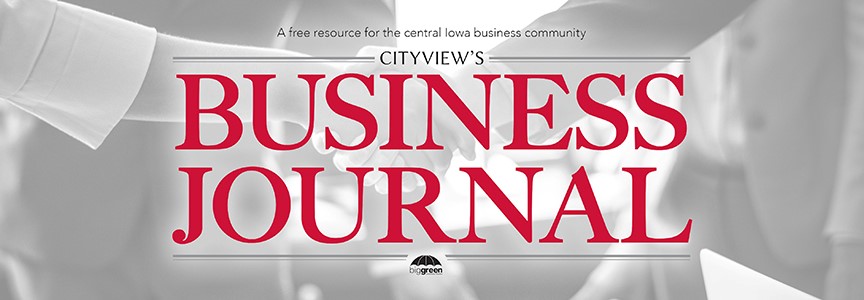Practical ways to increase productivity, boost morale and reduce stress at your small business
 It was evident from the start for Gina David that wellness was an important component of working at her new job.
It was evident from the start for Gina David that wellness was an important component of working at her new job.
David, the marketing director at McGowen, Hurst, Clark and Smith, P.C. in West Des Moines and Winterset, joined the company almost four months ago. She could immediately see the time and energy that goes into making wellness a top priority.
“It’s part of our culture of stay healthy and be happy,” she says.
Human resources experts agree: Companies need to encourage healthy living for their employees and take responsibility for supporting them in efforts to do so. Healthy employees have fewer days away from work, work harder and more efficiently, are happier at the office, and have fewer doctors’ appointments and insurance claims.
Ninety-three percent of small-business owners from a National Small Business Association survey say their employees’ physical and mental health is important to their bottom line, but only one-third felt they could manage their employees’ needs because of a lack of information given to employees and lack of employee interest in well-being initiatives, according to the U.S. Small Business Administration.
A wellness program doesn’t have to be something that’s set in stone, but it does need to be goal oriented,
interest employees, and be consistent and measurable, according to PeopleKeep, a Salt Lake City company that specializes in creating benefit packages for companies.
It can be as simple as providing occasional healthy snacks for the office to conducting an ergonomic assessment to make sure desks and chairs are set up correctly to starting a challenge to see who can walk the most steps or drink the most water.
Here are five ideas for supporting wellness in the workplace.
1. Remember to put employees first
The bottom line is important, but no company can reach its goals without healthy and productive employees.
That’s why the president of Performance Marketing and Shift Interactive initiated wellness and community
involvement programs for its 66 employees, says Rachel Bowley, a project manager with Shift, who also is a personal fitness/health coach and was asked to help with the wellness component.
Any wellness program should be created with the employee in mind. Even with that mindset, the company will still benefit and likely see an increase in productivity, better retention and less turnover, more interest from highly
qualified candidates and fewer insurance costs, according to PeopleKeep.

Dr. Wes Nyberg with Waukee Wellness and Chiropractic takes his employees, between two and six people, through the same program as he would a client and provides them with the same services. His goal is to personalize a health plan for his employees that fits whatever needs they have, whether they want to run a 5-kilometer race, lose weight or learn about aspects of the health industry by attending a conference.
In the National Small Business Association survey, business owners said they were most concerned with the
high level of stress they felt their employees had, as well as employees working when they are sick instead of taking a sick day.
Wellness initiatives for McGowen, Hurst, Clark and Smith, P.C.’s 70 employees are not incentive based because
the company believes the emphasis should be on promotion of wellness through fun and different activities, information and nutrition, David says.
“We have a diverse offering of options throughout the year so that everyone can participate in something they enjoy,” she says.
2. Take practical first steps
Business owners can start by looking around their office to see what employees have access to for food and physical activities. Those that offer
vending machines can easily manage the items offered by eliminating cookies and candy bars and replacing them with granola bars and other lower-calorie snacks.
If physical activity is an issue, provide employees with longer lunches, according to Inc., a publication that focuses on small businesses and startups. A longer lunch period gives employees time to go to the gym or for a walk rather than only eating.
Also reconsider the hours employees are considered on the clock, Inc. suggests. Keep work emails to work hours, and give employees their evenings and weekends to relax and focus on personal activities.
PeopleKeep says some small businesses give an “always on” vibe that can cause stress and burn-out, which deteriorates employees’ health. Encouraging employees to disconnect from work during off hours, to leave at a reasonable time, or even to browse the Internet can provide necessary breaks from workplace stresses.
Education also is key, according to the Wall Street Journal. Provide employees with calorie information for fast-food restaurants as well as other snack foods. In addition, have employees complete confidential health-risk assessments to learn about potential risk factors to their health. A business’ insurance company can often
provide a questionnaire or access to assessment information. A gift card will entice employees to participate.
Performance Marketing/Shift Interactive employees had biometric screenings and health assessments done this year that include height and weight, along with waist circumference measurements. That data was inputted into
an online wellness platform that an employee designed. It confidentially tracks each employee’s results as well as participation in wellness activities. If an employee participates in a steps or flights of stairs challenge, that information is recorded into the wellness platform. Employees can see their progress and changes from year to
year.
“It provides a little more sense of accountability for people to make a conscious decision to participate in things we have throughout the year,” Bowley says. “If you’re not shooting for an end goal, it gets a little tougher to have that buy in.”
Forty-two of the company’s employees participated in the screenings, which the company paid for. The same screenings will be done in a year to track progress and results, she says.
In addition to the assessments, business owners should evaluate their insurance claim data to determine if employees have any health issues that can be collectively addressed. A dietician or health-care professional can be brought in to share information with employees about issues such as high blood pressure or cholesterol. For
example, Strategic America in West Des Moines uses the aggregate results it receives from its 115 employees’ health screenings to determine information about blood pressure or stress level. A few years ago, the data showed that employees felt high levels of stress in the workplace. As a result, the company weaved in programming that discussed how to handle stress, says Carole Curtis, who serves on the wellness committee.
3. Create a plan that’s sustainable
Business owners should ask employees for their ideas about how to improve health and then utilize those ideas to create an overall wellness plan or program.
FitSmallBusiness, an online source that provides information to small-business owners, recommends employees be involved and assigned to research ideas and draft a plan. After business owners talk to employees, all of the ideas can be incorporated into a yearly calendar, so health initiatives can be planned for and scheduled
throughout the year. Business owners should post the calendar in a breakroom or public workspace area and give a copy to each employee. If employees know of activities in advance, they are more likely to participate or attend.
At Performance Marketing/Shift, the wellness committee has created 12 ideas that are incorporated throughout the year. These range from the health screening to lunch and learns about health and fitness. Each quarter, a large initiative is implemented that can include team challenges.
The U.S. Small Business Administration suggests employers reach out to the Centers for Disease Control for online resources to learn about worksite obesity controls and prevention and how much obesity is costing the company. The company’s health insurance provider and other small-business assistance groups, such as the
local Small Business Development Center, also may have advice or suggestions about wellness programs.
Gallup reports in its 2015 study that 80 percent of all employers offered wellness resources and information to employees, but most of those programs floundered because managers did not take a strong enough role in well-being initiatives.
Nyberg went through a personal transformation to get healthy about eight years ago, which he says helped him and his employees hold each other more accountable.
“That cliché is we have to practice what we preach,” he says. “If I’m going to be a health doctor and recommend certain things, I need to do that myself and so does my staff. They need to take an active role in their healthcare. We make sure we do that. If we expect our patients to do certain things, we do them, too.”
The program will be built into the company’s culture and should be followed by the upper levels of management with a “lead by example” mentality. This means any decisions that management makes about topics such as employee schedules or changes to the physical workspace should take employees’ health into consideration. The work environment should reflect the desire to promote a healthy lifestyle by making it easy for employees
to be physically active in ergonomically safe spaces and offering and supporting healthy initiatives, PeopleKeep suggests.
Performance Marketing/Shift wanted to keep the program going, Bowley says, so the wellness committee put together an annual budget to support the effort. The company budgets $3,600 a year to pay for biometric screenings for its employees, supplies for activities and rewards for employees.
As with any plan or program, management will want to review its success periodically, monthly or quarterly, and make changes based on feedback and results, according to FitSmallBusiness.
Plans or programs that tend to focus on a single approach to improve employee health and don’t modify or become part of the overall company culture will more than likely fail, according to a report by the Harvard Business Review.
Performance Marketing and its digital company Shift Interactive made changes to its wellness program from its inaugural year based on employee feedback. The wellness team discovered better participation earlier in the year that then trickled off, so they’ve spread out the health initiatives and now have individual and team challenges with rewards for those who participate.
4. Use a combination approach
Many businesses offer ways to improve an employee’s physical health, but there are ways to help with mental and emotional stress as well.
“We try not to position it as ‘fitness’ or ‘weight loss,’ ” Curtis says. “We want to be well-rounded with a focus on nutrition, physical activity, worklife balance and even financial health.”
At McGowen, Hurst, Clark and Smith, P.C., wellness initiatives are also directed toward safety such as first aid and CPR training, as well as community activism with blood drives and participation in Big Brothers/Big Sisters of
America’s Bowl For Kids’ Sake. Employees also can participate in ongoing professional training to benefit their career or a personal interest.
Overall well-being is key to employee performance, and those who thrive in the areas of purpose, social, financial, community and physical well-being miss less work, have greater customer satisfaction, create solutions and adapt to change more quickly, according to Gallup.
The companies that employ these individuals also save money in healthcare costs and turnover, with 81 percent less likely to seek new employment compared to those who only thrive in their physical well-being, Gallup reports.
Performance Marketing/Shift employees also have challenges that include water intake or tracking steps or flights of stairs. Points are awarded for individual efforts and participation in team challenges. Employees who participate — 65 percent participated last year in some health initiative — can receive gift cards or a Fitbit.
Anyone who participates receives recognition throughout the year to keep employees involved, Bowley says.
Any competition or challenge usually makes it more likely employees will participate, according to Inc. The longer the challenge, such as training to run or walk a race, the more likely employees will be to stick with their newfound exercise and wellness plan. Entice employees to participate by creating an incentives or rewards program to recognize and celebrate health success, according to PeopleKeep.
5. Think outside the box
Employees at Strategic America receive “wellness dollars” points for participating in wellness-related activities such as an online health assessment and biometric screening, being tobacco free, and participating in wellness
bingo, charity challenges and company outings that encourage physical activity.
Those points can be used for wellness-related expenses that include insurance premiums, gym membership fees, the purchase of exercise equipment for the home, smoking cessation programs and memberships to
food co-ops.
Strategic America’s wellness committee brainstorms ideas each year for month-by-month programming. Guest speakers provide information about health-related topics. Dried fruit, nuts, green tea and other healthy “heart”
foods were given to employees in February. Employees made green smoothies in March for St. Patrick’s Day. Summertime means a salad bar potluck.
Each month has a team or community building activity, Curtis says, and between 90 percent and 95 percent of employees participate in an event throughout the year.
At Waukee Wellness, Nyberg provides his employees with free chiropractic care and massage therapy. They also receive nutritional coaching and other services to help them meet their individual goals. If employees want to take the supplements Nyberg sells, he provides them at cost plus tax.
If business owners are unable to pay for a discounted membership or full membership to a fitness facility for their employees, they can check with local businesses to see if they offer free classes or specials.
Power Life, a yoga and fitness studio in Waukee and West Des Moines, offers a free month of classes for businesses that become involved with its corporate program.
Gabe Patten, who oversees the corporate program at Power Life, says it is available to any local business interested in offering the program to its employees. A Power Life instructor also will come to the business, as part of the program, and share information about yoga through a lunch-and-learn or a demonstration and provide tips about stretches employees can do at their desk.
About 92 percent of McGowen, Hurst, Clark and Smith, P.C. employees participate in the company’s corporate games, while everyone participates in some wellness initiative throughout the year. These include annual wellness screenings, chair massages and healthy snacks during the busy season, the corporate games, softball and basketball teams, and the Iowa Healthiest State Initiative walk. Each activity is re-evaluated depending upon participation and employee feedback.
“The diversity is there to allow everyone to participate,” David says.
The company also offers free water for its employees, monthly wellness tips and subsidizes a gym membership. Plus, the building is located next to a pond and walking trail, which many employees use throughout the week.
Performance Marketing/Shift Interactive organized a company outing at Title Boxing Club. The company also has invited local chiropractors to the office to conduct lunch and learns with employees. ♦


iphone 12 phone case
Simply desire to say your article is as astounding. The clearness for your submit is simply excellent and i can suppose you are knowledgeable on this subject. Well along with your permission allow me to clutch your feed to stay updated with impending post. Thanks 1,000,000 and please keep up the enjoyable work.|
the feed
Hey superb website! Does running a blog similar to this require a large amount of work? I’ve absolutely no understanding of coding however I had been hoping to start my own blog soon. Anyway, if you have any suggestions or techniques for new blog owners please share. I understand this is off subject nevertheless I simply wanted to ask. Kudos!|
FsfgAfter
viagra alternative viagra on line singapore viagra 100
FsfgAfter
viagra at cvs buying viagra in toronto buy viagra japan
the feed
Hi! I just wanted to ask if you ever have any trouble with hackers? My last blog (wordpress) was hacked and I ended up losing a few months of hard work due to no data backup. Do you have any methods to protect against hackers?|
feed
{
thefeed
Hi, I read your blog like every week. Your humoristic style is witty, keep it up!|
FsfgAfter
viagra livraison 24h super viagra plus viagra usa
cialis cheap cialis
cialis generic online
cialis cialis generic
buy cialis online cheap
canadian online pharmacy cialis
cialis 20 mg
atmospheric water generator price in india
After exploring a few of the blog posts on your website, I seriously like your way of writing a blog. I saved it to my bookmark webpage list and will be checking back soon. Please check out my website too and tell me what you think.|
cialis
hello guos 9128738517
superbeets review
When someone writes an paragraph he/she retains the idea of a user in his/her mind that how a user can be aware of it. Therefore that’s why this piece of writing is outstdanding. Thanks!|